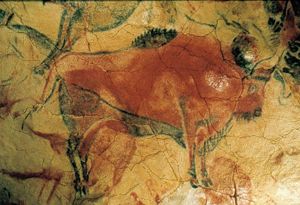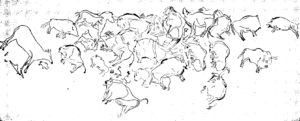Difference between revisions of "Altamira (cave)" - New World Encyclopedia
m (→External links) |
(Claimed) |
||
| Line 1: | Line 1: | ||
[[Category:Politics and social sciences]] | [[Category:Politics and social sciences]] | ||
[[Category:Anthropology]] | [[Category:Anthropology]] | ||
| − | + | {{Claimed}} | |
[[Image:Altamira Bison.JPG|thumb|300px|Cave painting of a Bison from Altamira]] | [[Image:Altamira Bison.JPG|thumb|300px|Cave painting of a Bison from Altamira]] | ||
Revision as of 20:45, 30 December 2006
Altamira (Spanish for 'high view') is a cave in Spain famous for its Upper Paleolithic cave paintings featuring drawings and polychrome rock paintings of wild mammals and human hands. It is located at {{#invoke:Coordinates|coord}}{{#coordinates:43|22|57|N|4|06|58|W|type:landmark | |name= }}, near the town of Santillana del Mar in Cantabria, Spain, 30 km west of the city of Santander. The cave with its paintings has been declared a World Heritage Site by UNESCO.
Description
The cave is 270 meters long, and consists of a series of twisting passages and chambers. The main passage varies from two to six meters high. The cave was formed through collapses following early karstic phenomena in the calcerous rock of Mount Vispieres.
Archeological excavations in the cave floor found rich deposits of Upper Solutrean (c. 18,500 years ago) and Lower Magdalenean (between c. 16,500 and 14,000 years ago) artifacts. The cave was occupied only by wild animals in the long period between these two occupations. The site was well positioned to take advantage of the rich wildlife that grazed in the valleys of the surrounding mountains as well as permitting the occupants to supplement their diet with food from nearby coastal areas. Around 13,000 years ago a rockfall sealed the cave's entrance preserving its contents until its eventual discovery which was caused by a nearby tree falling and disturbing the fallen rocks.
Human occupation was limited to the cave mouth although paintings were created throughout the length of the cave. The artists used charcoal and ochre or haematite to create the images, often scratching or diluting these dyes to produce variances in intensity and creating an impression of chiaroscuro. They also exploited the natural contours in the cave walls to give a three-dimensional effect to their subjects. The Polychrome Ceiling is the most impressive feature showing a herd of bison in different poses, two horses, a large hind and a possible wild boar.
This art is dated to the Magdelenean occupation and as well as animal subjects also included abstract shapes. Solutrean images include images of horses, goats and handprints created from the artist placing his hand on the cave wall in spraying paint over it leaving a negative image of his palm. Numerous other caves in northern Spain contain Palaeolithic art but none is as advanced or well-populated as Altamira.
Discovery, excavation, scepticisms
In 1879, amateur archaeologist Marcelino Sanz de Sautuola was led by his eight-year-old daughter to discover the cave's drawings. The cave was excavated by Sautuola and archaelogist Juan Vilanova y Piera from the University of Madrid, resulting in a much acclaimed publication in 1880 which interpretated the paintings as paleolithic in origin. The French specialists, led by Gabriel de Mortillet and Emile Cartailhac, were particularly adamant in rejecting the hypothesis of Sautuola and Piera, and their findings were loudly ridiculed at the 1880 Prehistorical Congress in Lisbon. Due to the supreme artistic quality, and the exceptional state of conservation of the paintings, Sautuola was even accused of forgery. A fellow countryman maintained that the paintings had been produced by a contemporary artist, on Sautuola's orders.
It was not until 1902, when several other findings of prehistoric paintings had served to render the hypothesis of the extreme antiquity of the Altamira-paintings less offensive, that the scientific society retracted their opposition to the Spaniards. That year, Emile Cartailhac emphatically admitted his mistake in the famous article, "Mea culpa d'une sceptique", published in the journal L'Anthropologie.
Sautuola, having died 14 years earlier, did not live to enjoy the restitution of his honour.
Further excavation work on the cave was done by Hermilio Alcalde del Río in 1902-04, the German Hugo Obermaier in 1924-25 and finally by Joaquín González Echegaray in 1981.
Visitors and replicas
During the 1960s and 1970s, the paintings were being damaged by the damp breath of large numbers of visitors. Altamira was completely closed to the public in 1977, and reopened to limited access in 1982. Very few visitors are allowed in per day, resulting in a three-year waiting list. A replica cave and museum were built nearby and completed in 2001 by Manuel Franquelo and Sven Nebel, reproducing the cave and its art. The replica allows a more comfortable view of the polychrome paintings of the main hall of the cave, as well as a selection of minor works. It also includes some sculptures of human faces that are not visitable in the real cave.[1]
There are other replicas in the National Archaeological Museum of Spain (Madrid), in the Deutsche Museum in Munich (completed 1964), and in Japan (completed 1993).
Cultural impact
Several painters were influenced by the Altamira cave paintings. After a visit, Picasso famously exclaimed "after Altamira, all is decadence".
Some of the polychrome paintings at Altamira Cave are well known in Spanish popular culture. The logo used by the autonomous government of Cantabria to promote tourism to the region is based on one of the bisons in this cave. Bisonte (Spanish for 'Bison'), a Spanish brand of cigarettes of the 20th century, also used a Paleolithic style bison figure along with its logo.
The Spanish comic character and series Altamiro de la Cueva, created in 1965, are a clear consequence of the fame of Altamira Cave. The comic series depicts the adventures of a group of prehistoric cavemen, shown as modern people, but dressed in pieces of fur, a bit like the Flintstones.
The rock band Steely Dan wrote the song "The Caves of Altamira" for their 1976 album, The Royal Scam.
Reference
- ↑ Travel Advisory; A Modern Copy Of Ancient Masters, The New York Times, 4 November 2001
Bibliography
- Curtis, Gregory. The Cave Painters: Probing the Mysteries of the World's First Artists. New York: Alfred A. Knopf, 2006 (hardcover, ISBN 1400043484)).
- Guthrie, R. Dale. The Nature of Prehistoric Art. Chicago: University of Chicago Press, 2006 (hardcover, ISBN 0226311260).
- McNeill, William H. "Secrets of the Cave Paintings", The New York Review of Books, Vol. 53, No. 16, October 19, 2006.
External links
- Altamira Cave National Museum In Spanish and English
- The story of Altamira
Credits
New World Encyclopedia writers and editors rewrote and completed the Wikipedia article in accordance with New World Encyclopedia standards. This article abides by terms of the Creative Commons CC-by-sa 3.0 License (CC-by-sa), which may be used and disseminated with proper attribution. Credit is due under the terms of this license that can reference both the New World Encyclopedia contributors and the selfless volunteer contributors of the Wikimedia Foundation. To cite this article click here for a list of acceptable citing formats.The history of earlier contributions by wikipedians is accessible to researchers here:
The history of this article since it was imported to New World Encyclopedia:
Note: Some restrictions may apply to use of individual images which are separately licensed.

